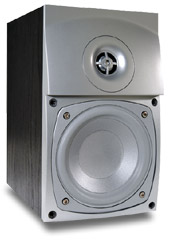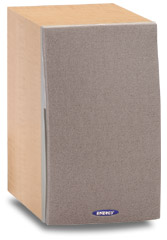Energy XL-150 Loudspeakers
 An
anechoic chamber is a room whose walls are lined with foam wedges designed to eliminate
all room reflections and outside interference. It’s a bit more complicated than that,
but such a space provides an environment in which you can take accurate sound measurements
without interference from outside sources, or the room itself. Energy, a subsidiary of
Audio Products International, was one of the many Canadian firms that benefited from
research in the Canadian National Research Council’s (NRC) anechoic chamber in
Ottawa. An
anechoic chamber is a room whose walls are lined with foam wedges designed to eliminate
all room reflections and outside interference. It’s a bit more complicated than that,
but such a space provides an environment in which you can take accurate sound measurements
without interference from outside sources, or the room itself. Energy, a subsidiary of
Audio Products International, was one of the many Canadian firms that benefited from
research in the Canadian National Research Council’s (NRC) anechoic chamber in
Ottawa.
This gives you an idea of the science behind the designs
that Energy builds. While the final voicing of a speaker is still partly art, Energy uses
science and research to help them get there. How a speaker behaves in the anechoic chamber
can help Energy predict how that speaker will behave in the average listening room. If you
think measurements aren’t important, think about the impact a severe dip in frequency
response can have at your listening position. By taking numerous frequency-response
measurements, both on- and off-axis, it’s possible for Energy to predict fairly
accurately how the total output will come together in a typical room. This kind of
information can be extremely useful in designing a speaker that will reduce the effects of
room interactions.
Just looking
At $200/pair USD, the XL-150 is the least expensive speaker
in the Energy line. For that relatively low price you get two exceptionally attractive
speakers. The review samples came in Energy’s finish of Canadian maple laminate with
a silver baffle; they were two of the most attractive budget speakers I’ve ever had
the pleasure of reviewing. I’ve seen some real-wood-veneer speakers that didn’t
look as nice as these.
The XL-150 is small: 7.9 pounds, 9.8" high, and
5.9" wide, but, at just over 9", a bit deeper than one might expect from a
speaker of this size. The cabinets are made of MDF, the aforementioned laminate wrapping
everything but the front baffle. The computer-designed silver baffle is made of a
copolymer that Energy calls e:XLite. Energy claims that the baffle is designed to be
rigid, and to reduce diffraction effects and resonances. The front face of the XL-150 is
covered by an equally attractive silver grillecloth contoured to match the baffle. The
grillecloth is held on by four plastic pins that insert into rubberized holes in the lower
half of the baffle. They take a bit more effort than normal to remove and attach, but they
hold the grille firmly in place.
The baffle is stepped, the tweeter mounted on a plane
forward of the woofer, rather than the more common arrangement of a recessed tweeter. The
driver complement comprises a 0.75" aluminum-dome tweeter with textile suspension and
a 5.5" injection-molded woofer. The frequency response is listed as 60Hz-20kHz, the
crossover point as 2.2kHz. Both drivers are shielded; this speaker can be placed close to
a TV. Efficiency is rated at 90dB "in-room" for the pair, with an impedance of 8
ohms. This should make a pair of XL-150s easy enough to drive for most any modern
solid-state amplifier. Around back you’ll find a port for enhanced bass response and
a pair of all-metal, gold-plated binding posts capable of accepting dual banana plugs,
bare wire, pins, or spades.
 The XL-150s were set up in my main listening room on 24" stands, which put
the tweeters right at ear level. Most well-behaved speakers sound best in this room
separated by slightly less distance between each other than the distance to my listening
chair, and the Energys were no exception. I tried other arrangements, but came back to my
standard setup. I tried the XL-150s pointing straight ahead and toed-in toward the
listening position, and quickly settled on the toed-in arrangement. As expected, the sound
wasn’t overly dependent on placement and was acceptable from virtually all speaker
placements and listening positions I tried. A little science is a wonderful thing. The XL-150s were set up in my main listening room on 24" stands, which put
the tweeters right at ear level. Most well-behaved speakers sound best in this room
separated by slightly less distance between each other than the distance to my listening
chair, and the Energys were no exception. I tried other arrangements, but came back to my
standard setup. I tried the XL-150s pointing straight ahead and toed-in toward the
listening position, and quickly settled on the toed-in arrangement. As expected, the sound
wasn’t overly dependent on placement and was acceptable from virtually all speaker
placements and listening positions I tried. A little science is a wonderful thing.
I used the Energy XL-150s with an Onkyo TX-DS696 receiver
and a Sony DVP-NS755V DVD player.
Listening
Lately, I’ve been doing a fair amount of listening to
Cassandra Wilson’s Traveling Miles [Blue Note 54123]. While this may not be
the critics’ favorite example of her work, it offers a handful of interesting
interpretations, something at which Wilson is particularly adept. In "Right Here,
Right Now," the marimba seemed to come from deep into the room, and the soundstage
extended to just beyond the speakers’ outer edges. The soundstage width was a bit
tighter than with many other speakers I have on hand, but the little Energys displayed
surprising depth and managed to entirely disappear, which is no small feat.
Another CD that’s spending a great deal of time
spinning around inside my CD player is Patricia Barber’s Modern Cool [Blue
Note 21811]. On "Postmodern Blues," the speakers completely disappeared again,
and the soundstage was significantly wider than it had been with other tracks, matching
other speakers I had on hand. I noticed that female vocals seemed to recede ever so
slightly into the background on this CD and on Traveling Miles. Speaking of lower
frequencies, the XL-150 produced an admirable amount of bass on this track, belying the
speaker’s small size.
Another vocal favorite is Jennifer Warnes’ The Well
[Sindrome 8960]. Her higher-pitched voice didn’t sound as recessed through the
Energys as those of Wilson and Barber. In a truly wonderful interpretation of Arlo
Guthrie’s "Patriot’s Dream," Warnes is joined by Guthrie himself. My
instant reaction was that Guthrie actually sounded a bit more like Willie Nelson. Fearing
it was a fault in the speakers, I switched over to my reference speakers (Silverline
Sonatinas) and played the track again. Never mind -- Arlo really does sound like
Willie on this cut. The XL-150s were doing their job superbly.
Fleetwood Mac’s Say You Will [Reprise 48394-2]
is the band’s first studio album in 16 years that features both Lindsay Buckingham
and Stevie Nicks. But Christine McVie is absent, and it’s never quite Fleetwood Mac
without her. Still, it’s a decent album that evokes memories of the complete group --
just don’t expect another Rumours. The XL-150s did a nice job of disappearing
into the background on the title track but, again, Stevie Nick’s voice was a bit
recessed. However, they displayed excellent imaging, with just a touch of soundstage
depth. Bass response was again well-defined, and I’m thrilled that Energy has again
resisted the temptation to boost bass output at the expense of accuracy. The XL-150 may
not go that low, but its bass never sounded exaggerated, as it does on so many small
speakers.
Pink Floyd’s The Wall [Capitol 31243] is
generally well-recorded, if not quite up to the standard of Dark Side of the Moon.
The XL-150 displayed surprisingly good transient response at the opening of "Is There
Anybody Out There?" The real treat was the excellent imaging and sound of the
creaking door at the opening of "Waiting for the Worms." My dog, who normally
goes crazy when somebody comes in the house, tore off for the front door, barking the
whole way. Yes, my front door creaks and the hinges should be lubricated, but that might
deactivate a perfectly good alarm system.
While Telarc’s recording of Tchaikovsky’s 1812
Overture [Telarc 80041] is best known for its woofer-killing cannon blasts, I tend to
prefer Capriccio Italien. The XL-150 got the tone right, with just the right amount
of warmth to the strings. Many speakers, especially budget models, get the tone too bright
or too dull. Getting the tone just where it’s supposed to be is an exercise in skill
and patience, and the Energy delivered.
Comparison
The nearest competitor I had on hand was the $328/pair Ascend Acoustics CBM-170. The Ascend has a cleaner, more
forward sound, and its upper octaves are brighter and more open than the Energy
XL-150’s. In contrast, the XL-150 presented a warmer, more laid-back sound. The bass
provided by each speaker is tight and articulate, but don’t expect either to excel at
heavy rock or organ music. While both do a reasonably good job down to 60 or 70Hz, neither
is capable of producing serious bass output on its own. That’s to be expected from
any minimonitor; attempts to produce much low-frequency energy from a small system
typically end up with a bass response that’s the musical equivalent of mush. If you
really crave deep bass, buy a subwoofer.
The Ascends are somewhat more detailed, but the Energy
XL-150 was much more forgiving of typically bright and harsh budget electronics. While the
Ascends sound great with many higher-end amplifiers and most mid-fi receivers,
they’re capable of highlighting the deficiencies of lesser electronics. I recently
found the Ascends to be surprisingly edgy with a widely respected budget receiver I had
around the house. Just out of curiosity, I switched to the Energy XL-150s and found them
to be much more engaging with this Big Box special. Which speaker I would prefer would
depend largely on what electronics I was teaming them with.
Then there are cosmetics. I know some of you will say that
the look of the speaker doesn’t matter, but I’d be willing to bet that the vast
majority who are of that opinion aren’t married. Suffice it to say that my wife
vastly prefers the looks of the Energys over those of the Ascends. I’ve had both
pairs sharing space in the same room for the last few months, and I agree with her. The
XL-150 is a very attractive speaker.
Conclusion
The Energy XL-150 is a strong competitor in an incredibly
tough price class. It does nothing overtly wrong, and a great many things right. While
it’s not the most detailed speaker in its class, it’s friendly to the frequently
harsh realities of budget electronics. Add to that its more than reasonable price and
class-leading cosmetics, and the Energy XL-150 is a speaker that should find a happy home
with many shoppers.
...Jeff Van Dyne
Price of equipment reviewed
|